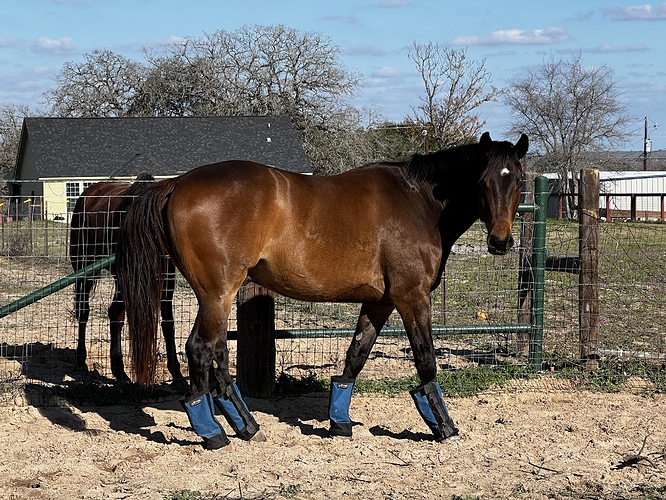My horse has been showing increasingly problematic behavior over the last few months. Starting in December. From the time he came back from the trainers to be broke he has had issues at the canter. We chalked it up to it being a strength issue. He would pig root or kick out his hind legs to swap leads going to the left. He can hold a canter just fine on the right. But most recently every once in a while he would strike off into a cross canter immediately on the right lead. I’d fix it an he wouldn’t do it again. With consistent work he is better about not pig rooting with the left lead and can hold it. More recently I can feel when he’s about to do it before he swishes his tail and if I tuck my pelvis and add leg then I can prevent it from happening all together.
It started at a schooling show in December. He put in a really nice and relaxed dressage test and got a 30. When we got to XC he completely froze when it was time to go into the woods and away from the other horses. I worked him through it and we finished in just under 8 minutes. I’ll tell you right now I have no idea how I got him through it after what happened this weekend.
We went back to the same show same division same course in January. Now he’s rearing in the dressage which was in the same arena. Tripping over himself. Doing really bad pig rooting and bucking during the show jump. He kicked out hard and high at least 6 times so I scratched from XC and called it a day. We had an outing yesterday with the intent to school at this place to give him some confidence. We walked around, we warmed up, everything was fine until we went to jump a tiny log. Tried to jump it 3 times and each time he’s bucking on the backside. Can’t even travel in a straight line. It was a mess. So I just stopped him and removed him from that situation. I wanted it to be a relaxing experience and if that meant no jumping I was fine with that. So we keep on exploring and I let him stop and look to his hearts content because now is the time to do it. Then he rears out of nowhere when I wasn’t even putting pressure on him. We were just standing there. I try to see if maybe trotting around would help and it didn’t. Tried to walk some more and he absolutely would not go down these trails so I just got off and led him the rest of the way and walked back to the trailer because he was mentally fried and it literally took nothing for him to get that way. He continues rearing and bucking at the trailer. He’s not buddy sour. He wasn’t wearing his tack at this point. His tack fits well. He loves his bit. He goes just great at home and at the instructors barn. We do really well XC at other venues. But he was down right neurotic this weekend. Out of precaution we treated him for epm and that did nothing. He’s being prophylactically treated for ulcers just in case that was it. He’s on a magnesium supplement. The only remarkable thing on his PPE was a spur in his right hock that the vet said was unlikely to bother him. But I’m wondering if he has kissing spine. He’s 75% thoroughbred and 25% Irish draught. I called Texas A&M to get an estimate for a lameness exam and they said it would be $1,000 and that included x rays and blocking. I said blocking? I don’t think it’s a lower extremity it seems like it’s higher up. He doesn’t feel off or lame. They said if they couldn’t block him they would need to do a $3,000 bone scan. I’m just wanting X-rays I didn’t know it would be such a hassle and require all this extra expensive stuff. So I’m still shopping around for where to go to get him assessed for kissing spine. And to at least have that hock looked at again. If he’s medically cleared then I think maybe he just needs another low pressure year to mature some more. This behavior is 100% out of character for him. He is well traveled, experienced, his foundation in his training is really well done. I don’t understand this neurotic fractious behavior if it’s not related to pain. I’ve done my best to never over face him intentionally. I think my biggest mistake was not schooling at this venue before I took him to the horse trial and really pushing him through that course to finish when he was telling me no may have traumatized him unintentionally.
Does this sound like it could be kissing spine? Or the hock? Or is this all just mental and he needs another year to mature?
This was his back last summer I was concerned because he has some prominent bumps along his spine. He has since developed a better topline.




 NPA/caudal failure can make their entire hind end/back sore and can really make KS worse.
NPA/caudal failure can make their entire hind end/back sore and can really make KS worse. ), so I would definitely investigate that, also.
), so I would definitely investigate that, also.